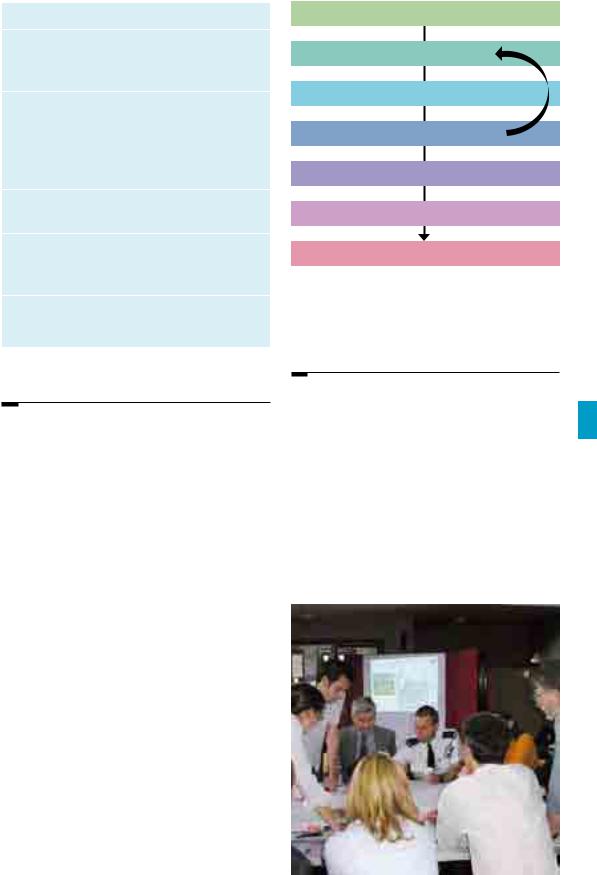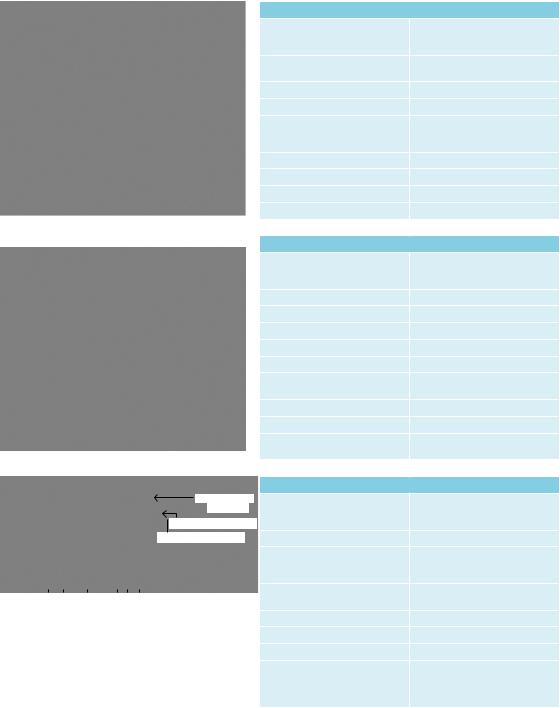

2 |
Streets in context
Andrew Cameron, WSP

Chapter aims
•Explain the distinction between ‘streets’ and ‘roads’.
•Summarise the key functions of streets.
•Propose a new approach to defining street hierarchies, based on their significance in terms of both place and movement.
•Set out the framework of legislation, standards and guidance that apply to the design of streets.
•Provide guidance to highway authorities in managing their risk and liability.
2.1Introduction
2.1.1 This chapter sets out the overall framework in which streets are designed, built and maintained.
2.1.2 The key recommendation is that increased consideration should be given to the ‘place’ function of streets. This approach to addressing the classification of streets needs to be considered across built-up areas, including rural towns and villages, so that a better balance between different functions and street users is achieved.
2.2Streets and roads
2.2.1 A clear distinction can be drawn between streets and roads. Roads are essentially highways whose main function is accommodating the movement of motor traffic. Streets are typically lined with buildings and public spaces, and while movement is still a key function, there are several others, of which the place function is the most important (see ‘Streets – an historical perspective’ box).
Streets – an historical perspective
Most historic places owe their layout to their original function. Towns have grown up around a market place (Fig. 2.1), a bridgehead or a harbour; villages were formed according to the pattern of farming and the ownership of the land.The layouts catered mostly for movement on foot.The era of motorised transport and especially privately-owned motor vehicles has, superficially at least, removed the constraint that kept urban settlements compact and walkable.
a
Figure 2.1 Newark: (a) the Market Place, 1774; and (b) in 2006.
When the regulation of roads and streets began, spreadoffirewasthemainconcern. Subsequentlyhealthcametotheforefrontandthe classic36ftwidebye-lawstreetwasdevisedasa meansofensuringthepassageofairindensely built-upareas.Later,thedesiretoguaranteethat sunshinewouldgettoeveryhouseledtothe requirementfora70ftseparationbetweenhouse fronts,andthisshapedmany developments from the 1920s onwards.
It was not until after the Second World War, and particularly with the dramatic increase in car ownership from the 1960s onwards, that traffic considerations came to dominate road design.
b
Andrew Cameron
Manual for Streets |
15 |

2.2.2Streets have to fulfil a complex variety of functions in order to meet people’s needs as places for living, working and moving around in. This requires a careful and multi-disciplinary approach that balances potential conflicts between different objectives.
2.2.3In the decades following the Second World War, there was a desire to achieve a clear distinction between two types of highway:
• distributor roads, designed for movement, where pedestrians were excluded or, at best, marginalised; and
• access roads, designed to serve buildings, where pedestrians were accommodated.
This led to layouts where buildings were set in the space between streets rather than on them, and where movement on foot and by vehicle was segregated, sometimes using decks, bridges or subways. Many developments constructed using such layouts have had significant social problems and have either been demolished or undergone major regeneration (Fig. 2.2).
2.2.4This approach to network planning limited multi-functional streets to the most lightly-trafficked routes. This has led to development patterns where busy distributor roads link relatively small cells of housing. Such layouts are often not conducive to anything but the shortest of trips on foot or by bicycle. It is now widely recognised that there are many advantages in extending the use of multi-functional streets in urban areas to busier routes.
2.2.5 Streets that are good quality places achieve a number of positive outcomes, creating a virtuous circle:
•attractive and well-connected permeable street networks encourage more people to walk and cycle to local destinations,
improving their health while reducing motor traffic, energy use and pollution;1
•more people on the streets leads to improved personal security and road safety
– research shows that the presence of pedestrians on streets causes drivers to travel more slowly;2
•people meeting one another on a casual basis strengthens communities and encourages a sense of pride in local environments; and
•people who live in good-quality environments are more likely to have a sense of ownership and a stake in
maintaining the quality of their local streets and public spaces.
2.2.6Well-designed streets thus have a crucial part to play in the delivery of sustainable communities, defined as ‘places where people want to live and work, now and in the future’.3
2.2.7Lanes in rural areas can provide other functions than just movement, including various leisure activities such as walking, cycling and horse riding.
1Snellen, D. (1999) The relationship between urban form and activity patterns. In Proceedings of the European Transport Conference, Cambridge, 1999. London: PTRC. pp. 429–439.
2ODPM and Home Office (2004) Safer Places: The Planning System and Crime Prevention. London: TSO.
3ODPM (2005) Planning Policy Statement 1: Delivering Sustainable Developments. London: TSO. (Wales: Welsh Assembly Government (2002) Planning Policy Wales. Cardiff: NAfW.)
Figure 2.2 A poor-quality space with a layout where pedestrians and vehicles are segregated. It has not been a success and the area is now undergoing regeneration.
16 |
Manual for Streets |

4Commission for Architecture and the Built Environment (CABE) and ODPM (2002)
Paving the Way: How we Achieve Clean, Safe and Attractive Streets. London: Thomas Telford Ltd.
5Communities and Local Government (2006)
Strong and Prosperous Communities: The Local Government White Paper. London: TSO.
6Department for Environment, Transport and the Regions (DETR) (1998) Places, Streets and Movement: A Companion Guide to Design Bulletin 32 – Residential Roads and Footpaths. London: TSO.
2.3Principal functions of streets
2.3.1Streets have five principal functions;
•place;
•movement;
•access;
•parking; and
•drainage, utilities and street lighting. These functions are derived from Paving the Way.4
Place
2.3.2The place function is essentially what distinguishes a street from a road. The sense of place is fundamental to a richer and more fulfilling environment. It comes largely from creating a strong relationship between the street and the buildings and spaces that frame it. The Local Government White Paper5 makes it clear that, in creating sustainable communities, local authorities have an essential and strategic role.
2.3.3An important principle was established in Places, Streets and Movement6 – when planning new developments, achieving a good place should come before designing street alignments, cross-sections and other details. Streets should be fitted around significant buildings, public spaces, important views, topography, sunlight and microclimate.
2.3.4A sense of place encompasses a number of aspects, most notably the street’s:
• local distinctiveness;
•visual quality; and
•propensity to encourage social activity (Fig. 2.3).
These are covered in more detail in Chapters 4 and 5.
2.3.5 The choice of surface materials, planting and street furniture has a large part to play in achieving a sense of place.The excessive or insensitive use of traffic signs and other street furniture has a negative impact on the success of the street as a place. It is particularly desirable to minimise the environmental impact of highway infrastructure in rural areas, for example, where excessive lighting and the inappropriate use of kerbing, signs, road markings and street furniture can urbanise the environment.
Movement
2.3.6 Providing for movement along a street is vital, but it should not be considered independently of the street’s other functions. The need to cater for motor vehicles is well understood by transport planners, but the passage of people on foot and cycle has often been neglected. Walking and cycling are important modes of travel, offering
a more sustainable alternative to the car, making a positive contribution to the overall character of a place, public health and to tackling climate change through reductions in carbon emissions. Providing for movement is covered in more detail in Chapters 6 and 7.
Lorraine Farrelly
Figure 2.3 A residential environment showing distinctive character.
Manual for Streets |
17 |

Llewelyn Davies Yeang
Figure 2.4 An example of a sustainable drainage system.
Access
2.3.7Access to buildings and public spaces is another important function of streets. Pedestrian access should be designed for people of all ages and abilities.
2.3.8Providing frontages that are directly accessible on foot and that are overlooked from the street is highly desirable in most circumstances as this helps to ensure that streets are lively and active places. The access function is covered in Chapters 6 and 7.
Parking
2.3.9 Parking is a key function of many streets, although it is not always a
requirement. A well-designed arrangement of on-street parking provides convenient access to frontages and can add to the vitality of a street. Conversely, poorly designed parking can create safety problems and reduce the visual quality of a street. Parking is covered in more detail in Chapter 8.
Drainage, utilities and street lighting
2.3.10 Streets are the main conduits for drainage and utilities. Buried services can have a major impact on the design and maintenance requirements of streets. Sustainable drainage systems can bring environmental benefits, such as flood control, creating wildlife habitats and efficient wastewater recycling (Fig. 2.4). Drainage and utilities are covered in Chapter 11, and street lighting is covered in Chapter 10.
2.4The balance between place and movement
2.4.1Of the five functions, place and movement are the most important in determining the character of streets.
2.4.2In the past, road design hierarchies have been based almost exclusively on the importance attributed to vehicular movement. This has led to the marginalisation of pedestrians and cyclists in the upper tiers where vehicular capacity requirements predominate. The principle that a road was primarily for motor traffic has tended to filter down into the design of streets in the bottom tiers of the hierarchy.
2.4.3This approach has created disjointed patterns of development. High-speed roads often have poor provision for pedestrian activity, cutting residential areas off from each other and from other parts of a settlement. In addition, the hierarchy does not allow for busy arterial streets, which feature in most towns and cities.
2.4.4Streets should no longer be designed by assuming ‘place’ to be automatically subservient to ‘movement’. Both should be considered in combination, with their relative importance depending on the street’s function within a network. It is only by considering both aspects that the right balance will be achieved. It is seldom appropriate to focus solely on one to the exclusion of the other, even in streets carrying heavier volumes of traffic, such as high streets.
2.4.5Place status denotes the relative significance of a street, junction or section of a street in human terms.The most important places will usually be near the centre of any settlement or built-up area, but important places will also exist along arterial routes, in district centres, local centres and within neighbourhoods.
2.4.6Movement status can be expressed in terms of traffic volume and the importance of the street, or section of street, within a network
– either for general traffic or within a modespecific (e.g. bus or cycle) network. It can vary along the length of a route, such as where a street passes through a town centre.
18 |
Manual for Streets |

Motorway
Movement status
Place status
Figure 2.5 Typical road and street types in the Place and Movement hierarchy.
High street
Residential street
Andrew Cameron, WSP and Bob White, Kent County Council
7New Roads and Street Works Act 1991. London: TSO.
8Traffic Management Act 2004. London: TSO.
9Department for Transport (2004) Network Management Duties Guidance. London: TSO.
10Welsh Assembly Government (2006)
Traffic Management Act 2004 Network Management Duty Guidance. Cardiff: NAfW.
11The two-dimensional hierarchy as a way of informing street design was developed by the EU project ARTISTS.
See www.tft.lth.se/ artists/
2.4.7Highway authorities assess the relative importance of particular routes within an urban area as part of their normal responsibilities, such as those under the New Roads and Streetworks Act 1991.7 One of the network management duties under theTraffic Management Act 20048 is that all local traffic authorities should determine specific policies or objectives for different roads or classes of road in their road network. See also the Network Management Duties Guidance9 published by
the Department forTransport in November 2004 (Wales: guidance published November 200610).This states that it is for the authority to decide the levels of priority given to different road users on each road, for example, particular routes may be defined as being important to the response times of the emergency services.
2.4.8Another way of assessing the movement status of a street is to consider the geographical scale of the destinations it serves. Here, movement status can range from national networks (including motorways) through to city, town, district, neighbourhood and local networks, where the movement function of motor vehicles would be minimal.
Place and movement matrix
2.4.9 Defining the relative importance of particular streets/roads in terms of place and movement functions should inform subsequent design choices. For example:
•motorways – high movement function, low place function;
•high streets – medium movement function, medium to high place function; and
•Residential streets – low to medium movement function, low to medium place function.
2.4.10 This way of looking at streets can be expressed as a two-dimensional hierarchy,11 where the axes are defined in terms of place and movement (Fig. 2.5). It recognises that, whilst some streets are more important than others
in terms of traffic flow, some are also more important than others in terms of their place function and deserve to be treated differently. This approach allows designers to break away from previous approaches to hierarchy, whereby street designs were only based on traffic considerations.
Manual for Streets |
19 |

12Department for Transport (2006) Setting Local Speed Limits. Circular 01/2006. London: TSO
13Department for Transport and Welsh Office (1993)
Welsh Office Circular 01/1993. Road Traffic Regulation Act 1984: Sections 81–85 Local Speed Limits. Cardiff: Welsh Office.
14UK Roads Board (2005) Highway Risk and Liability Claims
–A Practical Guide to Appendix C of The Roads Board Report ‘Well Maintained Highways
–Code of Practice for Highway Maintenance Management’, 1st edn.
London: UK Roads Board.
2.4.11In many situations it will be possible to determine the place status of existing streets by consulting with the people living there. Such community consultation is encouraged.
2.4.12In new developments, locations with a relatively high place function would be those where people are likely to gather and interact with each other, such as outside schools, in local town and district centres or near parades of shops. Streets that pass through these areas need to reflect these aspects of their design, which will have been identified at the masterplan/scheme design stage.
2.4.13Once the relative significance of the movement and place functions has been established, it is possible to set objectives for particular parts of a network. This will allow the local authority to select appropriate design criteria for creating new links or for changing existing ones.
2.4.14Movement and place considerations are important in determining the appropriate design speeds, speed limits and road geometry, etc., along with the level of adjacent development and traffic composition (see Department for Transport Circular 01/2006;12 Wales: Welsh Office Circular 1/199313).
2.5.3Parliament and the courts establish the legal framework within which highway authorities, planning authorities and other organisations operate.
2.5.4The Government develops policies aimed at meeting various objectives which local authorities are asked to follow. It also issues supporting guidance to help authorities implement these policies.
2.5.5Within this overall framework highway and planning authorities have considerable leeway to develop local policies and standards, and to make technical judgements with regard to how they are applied. Other bodies also produce advisory and research material that they can draw on.
2.6Risk and liability
2.6.1A major concern expressed by some highway authorities when considering more innovative designs, or designs that are at variance with established practice, is whether they would incur a liability in the event of damage or injury.
2.6.2This can lead to an over-cautious approach, where designers strictly comply with guidance regardless of its suitability, and to the detriment of innovation. This is not conducive to
2.5Policy, legal and technical context creating distinctive places that help to support
2.5.1There is a complex set of legislation, polices and guidance applying to the design of highways. There is a tendency among some designers to treat guidance as hard and fast rules because of the mistaken assumption that to do otherwise would be illegal or counter to a
stringent policy. This tends to restrict innovation, leading to standardised streets with little sense of place or quality. In fact, there is considerable scope for designers and approving authorities to adopt a more flexible approach on many issues.
2.5.2The following comprise the various tiers of instruction and advice:
• the legal framework of statutes, regulations and case law;
• government policy;
• government guidance;
• local policies;
• local guidance; and
• design standards.
thriving communities.
2.6.3In fact, imaginative and context-specific design that does not rely on conventional standards can achieve high levels of safety. The design of Poundbury in Dorset, for example, did not comply fully with standards and guidance then extant, yet it has few reported accidents. This issue was explored in some detail in the publication Highway Risk and Liability Claims.14
2.6.4Most claims against highway authorities relate to alleged deficiencies in maintenance. The duty of the highway authority to maintain the highway is set out in section 41 of the Highways Act 1980,15 and case law has clarified the law in this area.
20 |
Manual for Streets |

15Highways Act 1980. London: HMSO.
16 Road Traffic Act 1988. London: TSO.
16Disability Discrimination Act 2005. London: TSO.
17Disability Rights Commission (DRC) (2006)
Planning, Buildings, Streets and Disability Equality. A Guide to the Disability Equality Duty and Disability Discrimination Act 2005 for Local Authority
Departments Responsible for Planning, Design and Management of the Built Environment and Streets. London: DRC.
2.6.5The most recent judgement of note was Gorringe v. Calderdale MBC (2004), where a case was brought against a highway authority for failing to maintain a ‘SLOW’ marking on the approach to a sharp crest. The judgement confirmed a number of important points:
• the authority’s duty to ‘maintain’ covers the fabric of a highway, but not signs and markings;
• there is no requirement for the highway authority to ‘give warning of obvious dangers’; and
• drivers are ‘first and foremost responsible for their own safety’.
2.6.6Some claims for negligence and/or failure to carry out a statutory duty have been made under section 39 of the Road Traffic Act 1988,15 which places a general duty on highway authorities to promote road safety. In connection with new roads, section 39 (3)(c) states that highway authorities ‘in constructing new roads, must take such measures as appear to the authority to be appropriate to reduce the possibilities of such accidents when the roads come into use’.
2.6.7The Gorringe v. Calderdale judgment made it clear that section 39 of the Road Traffic Act 1988 cannot be enforced by an individual, however, and does not form the basis for a liability claim.
2.6.8Most claims against an authority are
for maintenance defects, claims for design faults being relatively rare.
2.6.9 Advice to highway authorities on managing their risks associated with new designs is given in Chapter 5 of Highway Risk and Liability Claims. In summary, this advises that authorities should put procedures in place that allow rational decisions to be made with the minimum of bureaucracy, and that create an audit trail that could subsequently be used as evidence in court.
2.6.10 Suggested procedures (which accord with those set out in Chapter 3 of MfS) include the following key steps:
•set clear and concise scheme objectives;
•work up the design against these objectives; and
•review the design against these objectives through a quality audit.
2.7Disability discrimination
2.7.1Highway and planning authorities must comply with the Disability Equality Duty under the Disability Discrimination Act 2005.16 This means that in their decisions and actions, authorities are required to have due regard to the six principles of:
•promote equality of opportunity between disabled persons and other persons;
•eliminate discrimination that is unlawful under the 2005 Act;
•eliminate harassment of disbled persons that is related to their disabilities;
•promote positive attitudes towards disabled persons;
•encourage participation by disabled persons in public life; and
•take steps to take account of disabled persons’ disabilities, even where that involves treating disabled persons more favourably than other persons.
2.7.2Those who fail to observe these requirements will be at the risk of a claim. Not only is there an expectation of positive action, but the duty is retrospective and local authorities will be expected to take reasonable action to rectify occurrences of non-compliance in existing areas.
2.7.3The Disability Rights Commission (DRC) have published a Statutory Code of Practice on the Disability Equality Duty and they have also published specific guidance for those dealing with planning, buildings and the street environment.17
Manual for Streets |
21 |

3 |
The design process– from policy to implementation
Llewelyn Davies Yeang

Chapter aims
•Set out the design process in broad terms and reinforce the importance of collaborative working.
•Demonstrate the advantages of local authorities following a DevelopmentTeam approach and emphasise the benefits of the developer engaging with the team at an early stage in the design process.
•Look at the key principles within the design process, and the use of design codes.
•Introduce a user hierarchy where pedestrians are considered first in the design process.
•Recommend a new approach to street and safety audits.
3.1Introduction
3.1.1The life of a scheme, from conception to implementation and beyond, can be broken down into seven key stages, as shown in Fig. 3.1.
3.1.2This seven-stage process is generally applicable to all schemes, from large new developments, through to smaller infill schemes and improvements to existing streets. The key aspects are that:
• design decisions reflect current policies;
• policies are interpreted on a case-by-case basis and are used to define objectives; and
• scheme designs are tested against these objectives before approval is given to their implementation.
3.1.3The process is a general one and should be applied in a way appropriate to the size and importance of the proposal.
For example, the design stage refers to the desirability of preparing a masterplan for large schemes. This is unlikely to be the case for smaller developments and improvement schemes for existing streets which are likely to be less complex, and, in some cases, a scheme layout is generally all that is required.
1.Policy review
2.Objective setting
3.Design
4.Quality auditing
5.Planning approval
6.Implementation
7.Monitoring
Figure 3.1 The seven key stages in the life of a scheme.
3.2Integrated street design
– a streamlined approach
3.2.1 The developer’s design team needs to engage with several departments within the local planning and highway authorities in order to identify all the relevant issues. It is therefore recommended that planning and highway authorities, together with other public agencies, such as those responsible for waste collection and drainage, coordinate their activities to ensure that they do not give contradictory advice or impose conflicting conditions on the developer and the design team (Fig. 3.2).
Llewelyn Davies Yeang
Figure 3.2 Multi-disciplinary collaborative planning helps identify all the relevant issues.
Manual for Streets |
23 |

1Communities and
Local Government (2006)
Circular 1/06 Guidance on Changes to the Development Control System. London: TSO. paragraph 76.
Case study
Walsall: the DevelopmentTeam approach
Walsall Council has successfully run a Development Team for some years. Developers submitting major planning applications benefit from meetings with officials representing a broad range of disciplines. They cover Highways, Pollution Control, Housing Services, Building Control, Development Control, Ecology, Landscape and Arboriculture (officials for these disciplines are always present), and Leisure Services, Education and the Environment Agency (officials for these disciplines are brought in as required).
3.2.2Local authorities should enable developers to engage effectively with individual departments by establishing a single point of contact. Some local authorities have created development teams so that all council departments with an interest in street design work together during the design and approval process (see ‘Walsall case study box’). Authorities that have adopted a similar approach for larger schemes include North Somerset District Council and Oxfordshire County Council
in association with the District Councils.This has clear advantages when dealing with large or small development proposals.The same approach can be adopted by local authorities internally when considering improvements to existing streets.
3.2.3The benefits of an integrated approach applies to all stages in the process, up to and including planning how the street will be maintained in future.
3.3Steps in the design process
3.3.1 The seven-stage process will need to be tailored to particular situations, depending on the type and complexity of the scheme. It is therefore recommended that, at the outset, a project plan is drawn up by the developer and agreed with stakeholders.The plan should include a flow chart diagram and an indication of the level and scope of information required at each stage.
From a list of available time slots at least 10 days in advance, applicants book a meeting with the DevelopmentTeam, submitting their preliminary proposals at the same time.This gives ample opportunity for initial consideration of the application, including site visits if necessary.
At the meeting, developers present their proposal to the Development Team where they receive initial comments and advice.
The Team provides a formal, written, fully considered response within three weeks.
Significant advantages of this approach are that the developers can plan their presentation to suit their development programme and the Team can offer advice on key elements of the proposal at an early stage, thus minimising the need for costly changes later on.
3.3.2Consultation with the public (including organisations representing particular groups) is not shown as a single, discrete stage. Public consultation should take place at appropriate points in the process. The timing and number of public consultation events will vary depending on the size and complexity of the scheme.
3.3.3Where schemes are significant because of their size, the site or other reasons, local planning authorities and developers are encouraged to submit them to the Commission for Architecture and the Built Environment (CABE) for Design Review at the earliest opportunity.1 Design Review is a free advice service offering expert, independent assessments of schemes.
3.3.4Table 3.1 shows how the process can be applied. It should be noted that these steps are indicative and will vary in detail from scheme to scheme.
3.4Stage 1: policy review
3.4.1Street designs should generally be consistent with national, regional and local policy. The process begins with a review of relevant planning and transportation policies, and the identification of the required key design principles.
3.4.2The starting point for the review of local policy is the Local Development Framework. The Local Transport Plan will need to be considered and authorities may also have prepared a Public
24 |
Manual for Streets |

Table 3.1 Indicative steps in the design process for new developments and changes to existing streets
Key stages |
Key activity/outputs |
Responsibility |
Large |
Small |
Changes |
|
|
|
|
development |
development |
to |
|
|
|
|
|
|
existing |
|
|
|
|
|
|
streets |
|
1. Policy review |
Review national, regional |
Design team |
3 |
3 |
3 |
|
|
and local policy context |
|
|
|||
|
|
|
|
|
|
|
|
Review LocalTransport Plan |
Design team |
3 |
|
3 |
|
|
Review Public Realm |
Design team |
3 |
|
3 |
|
|
Strategy |
|
|
|
||
|
|
|
|
|
|
|
|
Review any Street Design |
Design team |
|
|
|
|
|
Guidance not included in |
|
3 |
3 |
3 |
|
|
the Local Development |
|
|
|||
|
|
|
|
|
|
|
|
Framework |
|
|
|
|
|
2. Objective |
Prepare Development |
Planning and |
3 |
|
|
|
setting |
Brief |
highway authorities |
|
|
|
|
|
|
|
|
|||
|
Agree objectives |
All |
3 |
3 |
3 |
|
3. Design |
Carry out context |
Design team |
3 |
3 |
3 |
|
|
appraisal |
|
|
|||
|
|
|
|
|
|
|
|
Develop proposed |
Design team |
3 |
3 |
|
|
|
movement framework |
|
|
|
||
|
|
|
|
|
|
|
|
|
|
|
|
|
|
|
Prepare outline |
Design team, |
|
|
|
|
|
masterplan or scheme |
working closely |
3 |
3 |
3 |
|
|
|
|||||
|
layout |
with other |
|
|||
|
|
|
|
|
||
|
|
stakeholders |
|
|
|
|
|
Develop street character |
Design team |
3 |
3 |
3 |
|
|
types |
|
|
|||
|
|
|
|
|
|
|
|
Design street network |
Design team |
3 |
3 |
|
|
|
Produce detailed |
Design team |
|
|
|
|
|
masterplan or scheme |
|
3 |
3 |
3 |
|
|
layout |
|
|
|
|
|
|
Produce design code |
Design team |
3 |
|
|
|
4. Quality |
Carry out particular |
Prepared by design |
|
|
|
|
auditing |
audits required to |
team, considered |
3 |
3 |
3 |
|
|
assess compliance with |
by planning and |
|
|||
|
|
|
|
|
||
|
objectives |
highway authorities |
|
|
|
|
5. Planning |
Prepare design and |
Prepared by |
|
|
|
|
approval |
access statement |
design team for |
3 |
3 |
|
|
|
and other supporting |
approval by the |
|
|
||
|
|
|
|
|
||
|
documents |
planning authority |
|
|
|
|
|
Outline planning |
in consultation |
|
|
|
|
|
with the highway |
3 |
3 |
|
|
|
|
application |
|
|
|||
|
authority |
|
|
|
|
|
|
|
|
|
|
|
|
|
Full planning application |
|
3 |
3 |
|
|
6. |
Detailed design and |
Design team |
3 |
3 |
3 |
|
Implementation |
technical approval |
|
|
|||
|
|
|
|
|
||
|
Construction |
Promoter |
3 |
3 |
3 |
|
|
Adoption |
Highway authority |
3 |
3 |
|
|
7. Monitoring |
Travel plan |
Promoter |
3 |
|
|
|
|
Road user monitoring |
Highway authority |
|
|
3 |
|
Manual for Streets |
25 |

2Countryside Agency and Scottish Natural Heritage (2002) Landscape Character Assessment: Guidance for England and Scotland. London: TSO.
Realm Strategy or Open Space Strategy which will be of particular importance in establishing fundamental design principles. The policy review should also consider the national policy framework, particularly where the local policy framework is out of date or unclear.
3.5Stage 2: objective setting
3.5.1It is important that objectives for each particular scheme are agreed by all parties and reviewed later in the process to ensure that they are being met. Objectives need to reflect the local policies and the wider planning framework to ensure a consistency of approach across an area.
3.5.2On complex and lengthy projects, objectives may need to be reviewed and revised as the design process proceeds, with any changes agreed by all parties.
3.5.3Objectives should be expressed as outcomes that can be readily measured, and should not be expressed in vague terms, or require or invoke particular solutions. The objectives will often be related to the various activities expected to take place in particular locations and streets. There may also be objectives that apply across the whole of a new development area.
3.5.4Typical objectives might be:
•enabling local children to walk and cycle unaccompanied from all parts of a development to a school, local park or open space;
•promoting and enhancing the vitality and viability of a local retail centre;
•ensuring that a development will be served by public transport that is viable in the long term; and
•keeping traffic speeds at 20 mph or less in all streets on a development.
3.5.5Objectives could be expressed as a design checklist, which provides a simple
summary of the key aspects that need to be met.
3.5.6For some sites, a Development Brief or other form of guidance may have been prepared to establish the key principles of development, and will need to be taken into account at the objective setting stage.
3.6Stage 3: design
Context appraisal
3.6.1A context appraisal will normally be undertaken to determine how buildings and streets are arranged within the local area.This will be used to help determine an appropriate form for the development of, or changes to, existing streets.
3.6.2The context appraisal will identify how an area has developed in terms of form, scale, the pattern and character of streets and how a site or existing street relates to existing buildings and/or open space. It may also be appropriate to identify poor-quality streets or areas which need to be improved. One way of achieving this is by undertaking a Landscape Character Appraisal.2
3.6.3On smaller schemes it may only be necessary to consider context in a relatively local area, but this does not prevent designers from drawing on good-quality examples of local distinctiveness from the wider area.
a |
b |
Andrew Cameron, WSP |
Andrew Cameron, WSP |
Figure 3.3 New housing with: (a) good (b) poor integration into an existing street.
26 |
Manual for Streets |

Development opportunity sites View towards the river New active frontage onto London Road Conservation area Character buildings Green network Major riverside green
link/space (pedestrian) New aspect onto river Pedestrian links from station/interchange New street with possible bridge over railway Residential (existing) Employment & ‘consultation zone’ Existing vegetation Mixed use, higher density, centre focus
Railway station / interchange
Llewelyn Davies Yeang
Figure 3.4 An illustration of a context appraisal.
3.6.4 When existing streets are being redesigned, it is very important to have a detailed understanding of how they sit within an urban area. Care needs to be taken to retain and develop the relationship between the streets and the buildings and public spaces that surround them, and to capitalise on links to important local destinations.There is a need to identify opportunities to repair incomplete or poorquality connections (Fig. 3.3).
Analysis of existing places
3.6.5 As part of the context appraisal, the relative importance of existing places within the locality will need to be identified. Places to be identified include important buildings and public open spaces, and key destinations such as educational institutions and areas of employment or commerce (Fig. 3.4).
Manual for Streets |
27 |

Main vehicular routes
Secondary vehicular routes Homezone or pedestrian priority routes Pedestrian only routes
3.6.6The analysis will determine which places in the surrounding area need to be made accessible to local people, particularly on foot and by bicycle, and the appropriate design and layout of that area.
3.6.7This analysis will also help to establish whether additional centres of activity are required as part of a new development, such as a new local centre or school.
Analysis of existing movement patterns
3.6.8 It is recommended that the design of a scheme should follow the user hierarchy shown in Table 3.2.
Table 3.2: User hierarchy
Consider first |
Pedestrians |
||
|
|
Cyclists |
|
|
|
||
|
|
Public transport users |
|
|
|
Specialist service vehicles (e.g. |
|
|
|
emergency services, waste, etc.) |
|
Consider last |
|||
Other motor traffic |
|||
3.6.9 The hierarchy is not meant to be rigidly applied and does not necessarily mean that it is always more important to provide for pedestrians than it is for the other modes. However, they should at least be considered first, followed by consideration for the others in the order given. This helps ensure that the street will serve all of its users in a balanced way. There may be
situations where some upper-tier modes are not provided for – for example, buses might not need to be accommodated in a short, narrow section of street where access for
cars is required.
3.6.10An analysis of movement within an existing settlement will help identify any changes required for it to mesh with a new
development. It could also influence movement patterns required within the
new development.
3.6.11The position of a street within the existing movement framework will determine the demands it needs to meet, and these, in turn, will inform decisions on its capacity, cross-section and connectivity.
3.6.12Establishing the movement requirements of existing streets is particularly important when changes are planned so that the needs of all road users are fully taken into account.
Proposed movement framework
3.6.13 For new developments, an understanding of how an existing area functions in terms of movement and place enables the proposed points of connection and linkage to be identified, both within and from the site, so that important desire lines are achieved.This process will help ensure that a new development enhances the existing movement framework of an area rather than disrupting or severing it (Fig. 3.5).
Llewelyn Davies Yeang
Figure 3.5 Proposed movement diagram for the redevelopment of RAF Halton.
28 |
Manual for Streets |

Figure 3.6 A concept masterplan with 3-D visualisation.
3.6.14 Guidance on the design of movement frameworks is set out in more detail in Chapter 4. The movement framework is a key input to the development of the masterplans.
Outline masterplan or scheme layout
Department for Transport 100039241 2007
Llewelyn Davies Yeang / ©Crown copyright. All rights reserved
a
3.6.15Although not always needed, especially where proposals are small scale, an outline masterplan helps to establish the scheme’s broad development principles (Fig. 3.6).
3.6.16An outline masterplan that has been produced through collaboration with key stakeholders is usually more robust and
realistic than it would otherwise be. For larger sites, a series of stakeholder events is often the most productive way of achieving this as it brings all the parties together to generate a design vision which reflects community and stakeholder objections. For smaller sites, the process need not be so involved and design proposals may be more appropriately informed by a simple scheme layout developed though targeted meetings with key stakeholders and/or correspondence.
3.6.17For simpler schemes adequately served by detailed layouts, outline scheme layouts are usually not likely to be needed (Fig. 3.7). An exception might be where, for example, the site is in a conservation area.
b
Figure 3.7 Small scheme design for an infill development (a) outlined in red. Location of new houses (b) shown in green together with
new access street. Note that the new access street can be extended to allow for future growth at the top of the diagram.
Manual for Streets |
29 |

3.6.18The outline masterplan will bring together the movement framework with other important aspects of the design of a new development, such as the need for new local facilities, important views and microclimate considerations.
3.6.19When developing outline masterplans for large-scale proposals, such as an urban extension, the design team needs to consider the longer-term vision for the area in question. Such a future-proofing exercise involves looking beyond the usual planning periods to consider where development may be in, say, 20 or 30 years. The issues identified may influence the masterplan. An example would be allowing for the future growth of a settlement by continuing streets to the edge of the site so that they can be extended at a later date (Fig. 3.8).This principle also applies to smaller-scale schemes which need to take account of future development proposals around an application site and, where appropriate in discussions with the local planning authority, to ensure that linkages are established wherever possible and that the site is swiftly integrated into its surroundings.
Street character types
3.6.20Once the outline masterplan has been prepared, the next step will be to establish the characteristics of the various types of street that are required for the new development.
3.6.21Street character types set out not only the basic parameters of streets, such as carriageway and footway widths, but also the street’s relationship to buildings and the private realm, and other important details, such as parking arrangements, street trees, planting and lighting.
3.6.22Further guidance on determining street character types is given in Chapter 7.
3.6.23Street character types can also be expressed through design codes, which are discussed later in this chapter.
Street network
3.6.24 It is recommended that the proposed street network is based on a combination of the proposed movement framework and the proposed street types (Fig. 3.9).
b
a
©Crown copyright. All rights reserved Department for Transport 100039241 2007
Figure 3.8 Ballater, Aberdeenshire – the ability for future growth is not compromised in the south-west of the village (a) with its permeable street pattern, but more recent cul-se-sac type development in the north-east (b) does not allow for a connected growth of the village.
30 |
Manual for Streets |

Detailed masterplan or detailed scheme layout
3.6.25Detailed masterplans are likely to be needed for schemes at the higher end of the scale in terms of size and complexity. For relatively simple proposals, a detailed
scheme layout is all that is likely to be needed. Guidance on the masterplanning process is given in Creating Successful Masterplans:
A Guide for Clients.3
3.6.26It is important when preparing a detailed masterplan, that all of the critical features which impact on the efficiency and quality of the development – and which cannot be changed once it is built – are carefully considered (Fig. 3.10).
3.6.27The full extent of the masterplanning process is beyond the scope of MfS, but it is recommended that the following key features relating to street design are addressed:
• connections to the surrounding area;
• connections through the site;
• street layout and dimensions;
• building lines;
• building heights;
• routes for utilities;
 English Partnerships, EDAW and Alan Baxter & Associates
English Partnerships, EDAW and Alan Baxter & Associates
Figure 3.9 Street network diagram for Upton, Northamptonshire, showing the main route through a connected layout and linkages to key spaces and places within the development, with street character types identified.
•parking provision, design and control;
•landscape design and structural planting;
•materials, management and maintenance regime;
•servicingandaccessforemergencyvehicles;
•speed control; and
•SUDS and sewer routes.
3CABE (2004) Creating Successful Masterplans: A Guide for Clients.
London: CABE
Figure 3.10 An example of a large-scale masterplan – Sherford New Community near Plymouth.
Red Tree LLP, The Prince’s Foundation and Paul Murrain
Manual for Streets |
31 |

Design codes
3.6.28 Design codes are an effective mechanism for implementing the masterplan (Fig. 3.11). They comprise detailed written and graphically presented rules for building out a site or an area. They are often promoted by local authorities but they may be put forward by the private sector.
3.6.29Design codes determine the twoand three-dimensional design elements which are key to the quality of a development. Although not appropriate in all circumstances, they can be valuable for helping local authorities and developers to deliver high-quality design.
3.6.30The elements which are coded will differ according to circumstances, but they might include aspects relating to layout, townscape
|
|
|
|
|
|
|
|
|
|
|
|
|
|
Footway min. 3.0 m |
Parking 5.0 m |
Carriageway 5.0 m |
Footway min. 2.0 m Private |
Step-back
 Max. height
Max. height
 Occupied or unoccupied roof
Occupied or unoccupied roof
Shoulder/eaves height
S.04.1 River’s edge • Plot series
Plot series
Attribute
Priority relative to street
Sub-series
Series type (regular/mixed)
Plot width at frontage (dimension range)
Point of access (type and frequency)
Pedestrian
Vehiclar
Allowable plot types
S.04.2 River’s edge • Plan
Public highway
Attribute
Carriage width
Footpath width
Design speed
Traffic calming
Junction radii
Vehicle type to be accommodated
On-street parking
Direct access to plots
Street trees
S.04.3 River’s edge • Section
Street section
Attribute
Shoulder/eaves height
Storey height
Maximum height of roof occupied or unoccupied
Step-back
Balconies
Vertical position of access
Vertical mix of uses
Riverside
Character area
Code
Active frontage must be orientated toward the street
Regular
6 m – 12 m; exceptionally, larger width, in increments of 5 m, with vertical articulation of module visible in the façade
Minimum every 12 m
None
Attached
Riverside
Character area
Code
6.0 m
Min 2.0 m, Min 3.0 m along riverfront
20 mph
Carriageway narrowing
Min. 40 m
Cars, small service vehicles, fire appliances, cycles
Perpendicular – 5.0 m x 2.5 m
No
8.0 – 12.0 m spacing between trees (adjust to accommodate parking areas)
Riverside
Character area
Code
3 – 5 storey
Floor to ceiling heights on the ground floor must be a minimum of 2.7m to allow for flexibility of use and adaptability
3 m above shoulder/eaves height
2.5 m maximum
1.5 m maximum
Level
Residential on ground floor, retail on ground floor around junctions of Burrell Street and Water Lane, residential above ground floor
Roger Evans & Associates
Figure 3.11 Design code for riverside development in Rotherham.
32 |
Manual for Streets |

4Communities and Local Government (2006)
Preparing Design Codes
– A Practice Manual.
London: RIBA Publishing.
and landscape considerations, or architecture or building performance. Codes may also usefully establish the relationships of plots, sometimes the building form or even materials. However, given the primary need to secure a quality townscape and a sense of place, the most important role of a design code will be in securing the lasting structural elements of a place, such as the street pattern and street dimensions. Getting these structural elements right will enable the other elements of a design to evolve. To do this successfully, however, the design code will need to be underpinned by a specific design vision, such as a masterplan or a design and development framework.
3.6.31A key benefit of design codes is the collaborative nature of their preparation – a process that brings together a broad range
of professionals and organisations with a role in delivering the development. Typically, this comprises land, design, development and public interests. Regardless of whether a code is promoted by the private sector or a local authority, it is essential that engineers, designers and planners work together to develop the code to help ensure that each aspect of the design successfully reinforces the overall sense of place.
3.6.32When a code is prepared by a local authority, a DevelopmentTeam approach will bring advantages. Representatives from the authority’s key departments will need to work together.These will include planning (both policy and development control), highways, landscape, parks and recreation, and, where appropriate, the housing authority and the authority’s estates
Design codes
Street-related design elements and issues which a design code may relate to include:
•the function of the street and its position in the Place and Movement hierarchy, such as boulevards, high streets, courtyards, mews, covered streets, arcades or colonnades;
•the principal dimensions of streets;
•junctions and types of traffic calming;
•treatments of major junctions, bridges and public transport links;
management team.The inclusion of the authority’s legal team will also be helpful, particularly where the codes relate to planning conditions, section 106 and 278 agreements, unilateral undertakings or local development orders. In particular, the highways team in an authority plays a key role in the preparation of a design code and in adopting the infrastructure that results.
3.6.33 Detailed guidance on the preparation and implementation of design codes, including advice on how they can be formalised, is set out in Preparing Design Codes – A Practice Manual.4
This guidance makes it clear that:
‘Highways policy and standards are decisive influences on design code preparation, and design codes provide a key opportunity
to improve highways design that takes account of urban design considerations and helps create quality places. The preparation of a design code can provide a ready opportunity to work closely with highways authorities to review any outdated local highways standards.’
3.6.34 In this context it is essential that, when design codes are being prepared, the coding team consider carefully what the design objectives are and the required outcomes to deliver those objectives. It is recommended that careful consideration should be given to the scope for the design code to address those aspects of the street environment that will be crucial to delivering the required outcomes. Those which are not can be left to the discretion of the developer and his or her designer
(see box and Fig. 3.12).
•location and standards for on-and off-street parking, including car parks and parking courts, and related specifications;
•street lighting and street furniture specifications and locations;
•specifications for trees and planting;
•location of public art;
•drainage and rainwater run-off systems;
•routeing and details of public utilities; and
•arrangements for maintenance and servicing.
Manual for Streets |
33 |

|
a |
Criteria |
|
|
Street Specification |
|
|
|
|
Standard Design |
Variation 1 (One-sided parking) |
Variation 2 (Variable Kerb) |
|
|
|
|
|
|
|
|
|
|
Design Speeds |
|
|
|
|
|
|
Speed Limit |
20 mph (at entrance) |
|
|
|
|
|
Control Speed |
20 mph (internally) |
|
|
|
|
|
|
|
|
|
|
|
|
Street dimensions and character |
|
|
|
|
|
|
Minimum |
5.5 m |
|
|
|
|
|
carriageway width |
|
|
|
|
|
|
Footway |
2.0-3.0 m on each side |
|
|
|
|
|
Cycle way |
No - Parallel routes provided on other streets |
|
||
|
|
Verge |
No |
|
|
|
|
|
Private strip |
2.0 m |
|
|
|
|
|
Direct vehicular |
Yes |
|
|
|
|
|
access to properties |
|
|
|
|
|
|
Plot Boundary Treatment |
2.0 m private area to building line with up to 1.0 m encroachment 0.9-1.1 m railing on plot boundary with footway |
|||
|
|
Maximum number of properties served |
Not restricted |
|
|
|
|
|
|
|
|
|
|
|
|
Public Transport |
|
|
|
|
|
|
Bus access |
No |
|
|
|
|
|
|
|
|
|
|
|
|
Street design details |
|
|
|
|
|
|
Pull out strip |
No |
|
|
|
|
|
Traffic calming |
Features at 60 m-80 m |
|
Non parallel kerbs, variations in planting/ |
|
|
|
|
c/c, parking, trees, formal |
|
building lines, parking |
|
|
|
|
crossings |
|
|
|
|
|
Vehicle swept path to be accommodated |
Removals/refuse vehicles enter and leave using own side of road |
Refuse vehichle passing car on street |
||
|
|
|
only (assuming 20 mph) |
|
|
|
|
|
On street parking |
Yes, both sides, 2.0 m wide |
Yes, one side, 2.0 m wide |
Yes, one or both sides, informal |
|
|
|
Gradients (footways) |
1:15 Maximum, footway to follow carriageway |
|
||
|
|
Maximum foward visibility |
33 m, 20 m (measured 1.0m out from kerb) |
|
||
|
|
Junction sightlines (x/y) |
2.4 m/33 m |
|
|
|
|
|
Junction spacing-same side/other side |
60 m/30 m |
|
|
|
|
|
Junction radii |
4 m |
|
|
|
|
|
Stats services (excluding storm and capping |
In footway, each side. |
Footways, where necessary |
|
|
|
|
layer drainage |
Drainage below carriageway |
|
|
|
|
|
|
|
|
|
|
|
|
Materials |
|
|
|
|
|
|
Footway Surfacing |
• Natural grey, pre-cast concrete paving flags, 63 mm thick staggered joint, variable sizes: 600x450 mm, 450x450 mm- |
|||
|
|
|
|
10%, 300 x 450 mm |
|
|
|
|
Parking Zone |
• Natural grey tumbled pre-cast concrete paviors 80 mm |
n/a |
||
|
|
|
|
thick with 225-300 mm exposed granite aggregate pre-cast |
|
|
|
|
|
|
kerb 20 mm high |
|
|
|
|
Kerbing |
• 225-300 mm wide x 200 mm square edged exposed granite aggregate pre-cast kerb 125 mm high |
|||
|
|
|
• 225-300 mm wide x 200 mm square edged exposed granite aggregate pre-cast kerb 20 mm high |
|||
|
|
Carriageway |
• |
Black-top |
|
|
|
|
|
• 5 rows of 100 mm x 100-250 mm cropped granite setts |
|
||
|
|
Pedestrian Crossing |
• |
Stainless steel tactile |
Tactile Paving |
|
|
|
|
|
studs inserted into |
|
|
|
|
|
|
paving/tactile paving |
|
|
|
|
Street Lighting |
LC4, LC5 Maximum to eaves height (see Appendix 4) |
|
||
|
|
Street Furniture |
SF3, SF6, SF9 (see Appendix 4) |
|
|
|
|
|
|
|
|
|
|
|
|
Trees |
|
|
|
|
|
|
Street Trees |
Acer platanoides ‘Obelisk’ |
|
|
|
|
|
Feature Trees |
Corylus Colurna - specific locations detailed in Development Briefs |
|
||
Figure 3.12 (a) and (b) Design code for particular street character type in Upton, Northampton (note (b) is on the next page).
English Partnerships, EDAW and Alan Baxter Asssoicates
34 |
Manual for Streets |

b
English Partnerships, EDAW and Alan Baxter & Asssoicates
Manual for Streets |
35 |

5 PERS (Pedestrian Environment Review System) is software developed by TRL and provides one way of carrying out a walking audit. For further details see www.trlsoftware. co.uk/products/detail. asp?aid=16&c=4&pid=66.
6TRL (unpublished) Cycle Environment Review System.
7Institution of Highways and Transportation (IHT) (1998) Cycle Audit and Cycle Review. London: IHT.
8Highways Agency (HA) (2005) HD42 NonMotorised User Audits
– Volume 5 Sections 2 Part 5. Design Manual for Roads and Bridges. London: TSO.
9Living Streets (2003) DIY Community Street Audit Pack. London: Living Streets.
10Guidance on Placecheck is available at www. placecheck.info.
11Department for Transport (2002) Inclusive Mobility A Guide to Best Practice on Access to Pedestrian and Transport Infrastructure. London:
Department for Transport.
12Centre for Accessible Environments (2004) Designing for Accessibility. London: RIBA Publishing.
13IHT (1996) The Safety Audit of Highways. London: IHT.
14HA (2003) HD19 Road Safety Audit – Volume 5 Section 2 Part 2. Design Manual for Roads and Bridges. London: TSO.
3.7Stage 4: quality auditing
3.7.1Properly documented design audit and sign-off systems are important. They help ensure that street designs are appropriate and meet objectives agreed at the outset. Such audits may include documents required by the local planning authority to support an outline or detailed application. In existing streets, quality audits provide an opportunity for decision makers to make a balanced assessment of different considerations before approving a particular solution (see ‘Devon case study box’).
3.7.2Being made up of a series of assessments, a quality audit is likely to be carried out by various professionals and each may be undertaken within particular guidelines. By grouping the assessments together, any compromises in the design will be apparent, making it easier for decision makers to view the scheme in the round.
3.7.3Auditing should not be a box ticking exercise. It is an integral part of the design and implementation process. Audits inform this process and demonstrate that appropriate consideration has been given to all of the relevant aspects. The quality audit may include some or all of the following, or variations on them, depending on the nature of the scheme and the objectives it is seeking to meet:
•an audit of visual quality;
•a review of how the streets will be used by the community;
•a road safety audit, including a risk assessment (see below);
•an access audit;
•a walking audit;5
•a cycle audit;6, 7
•a non-motorised user audit;8
•a community street audit (in existing streets);9 and
•a Placecheck audit.10
3.7.4Access auditors should take account
of the advice given in Inclusive Mobility.11 The Centre for Accessible Environments has also published guidance on access audits in relation to public buildings.12 It contains much useful general advice on access auditing in the public realm.
Case study
Devon: quality audit
Devon County Council
Figure 3.13 Road safety officers, police and engineers working on a road safety audit in Devon.
Devon County Council has developed a process whereby both an environmental audit and a road safety audit (Fig. 3.13) are carried out when improvement schemes are being prepared.
The two audits are carried out separately and if there is a difference of opinion between the two over any aspect, the matter is referred to a senior officer for a decision. It is therefore possible to demonstrate that decisions have been properly considered in case of future dispute.
This process is, in essence, a quality auditing process.
Road safety audits
3.7.5Road safety audits (RSAs) are routinely carried out on highway schemes.The Institution of Highways andTransportation (IHT) Guidelines on RSA13 sit alongside the HighwaysAgency standard contained in DMRB14 as the recognised industry standard documents in the UK.The procedures set out in DMRB are a formal requirement only for trunk roads.
3.7.6RSAs are not mandatory for local highway authorities. Many residential streets, where the design is carried out by a developer’s consultant, are assessed independently by the local highway authority. In some authorities there is no requirement for a further check by an RSA team, particularly where it is clear that motorised traffic volumes and speeds, and the degree of potential conflict between different user-groups, are not going to be significant.
36 |
Manual for Streets |

15UK Roads Board (2005) Highway Risk and Liability Claims
–A Practical Guide to Appendix C of The Roads Board Report ‘Well Maintained Highways
–Code of Practice for Highway Maintenance Management’, 1st edn.
London: UK Roads Board.
16Communities and Local Government (2006)
Circular 01/06 Guidance on Changes to the Development Control System. London: TSO.
17CABE (2006) Design and Access Statements – How to Write, Read and Use Them. London: CABE.
18Disability Rights Commission (DRC) (2005)
Planning, Buildings, Streets and Disability Equality. Stratford upon Avon: DRC.
19ibid. (16).
3.7.7The purpose of the RSA is to identify road safety problems, with the objective of minimising the number and severity of casualties. An RSA is not a check on compliance with design standards. Audits take all road users into account, including pedestrians and cyclists.The standard procedure is that the auditor makes recommendations for changes to the design to address perceived safety concerns.The design team reviews the RSA report and decides whether or not to accept particular recommendations.
3.7.8It is important to note that the design team retains responsibility for the scheme, and is not governed by the findings of the RSA.There is therefore no sense in which a scheme ‘passes’ or ‘fails’ the RSA process. Designers do not have to comply with the recommendations of a safety audit, although in such cases they would be expected to justify their reasoning in a written report.
3.7.9The process set out in DMRB requires the audit team to be independent of the design team. Road safety issues are therefore often considered in isolation from visual quality and Placemaking issues, and it can be difficult to achieve a balanced design through dialogue and compromise. However, the requirement for independence need not prevent contact between the design team and the audit team throughout the process.
3.7.10It is beyond the scope of MfS to
define in detail a wholly new and more balanced approach to RSAs, and the IHT guidelines are due to be revised. However, involving road safety professionals as an integral part of the design team could help to overcome some of the reported problems.This allows ideas to be tested and considered in more balanced and creative ways.
3.7.11 One area of concern with the existing system is that RSAs may seek to identify all possible risks without distinguishing between major and minor ones, or quantifying the probability of them taking place. There can also be a tendency for auditors to encourage designs that achieve safety by segregating vulnerable road users from road traffic. Such designs can perform poorly in terms of streetscape quality, pedestrian amenity and security and, in some circumstances, can actually reduce safety levels.
3.7.12 It would therefore be useful if RSAs included an assessment of the relative significance of any potential safety problems.
A risk assessment to consider the severity of a safety problem and the likelihood of occurrence would make it considerably easier for decision makers to strike an appropriate balance. An example of a risk assessment framework is given in Highway Risk and Liability Claims.15
3.1.13 Careful monitoring (such as through conflict studies) of the ways in which people use the completed scheme can identify any potential safety problems. This can be particularly useful when designers move away from conventional standards. Monitoring is discussed further in Section 3.10 below.
3.8Stage 5: planning approval
3.8.1New development proposals need to be submitted for approval to the planning authority who, in turn, consults with the local highway authority on street design issues.
3.8.2Where outline planning permission is being sought, various supporting information needs to be provided as agreed with the planning and highway authorities. This may include some or all of the following, depending on the type size and complexity of the scheme (this list is not necessarily exhaustive):
• preliminary street designs and layouts;
• a Design and Access Statement (see box);16, 17, 18
• a Transport Assessment;
• a Travel Plan;
• an Environmental Statement or Environmental Impact Assessment;
• a Sustainability Appraisal;
• a Flood Risk Assessment; and
• a Drainage Report.
Design and Access Statement
Since August 2006, Design and Access Statements (DASs) have been required for most planning applications for new developments.19 DASs are documents that explain the design thinking behind a planning application and are therefore important documents. They normally include a written description and justification of the planning application, often using photographs, maps and drawings to help clarify various issues.
Manual for Streets |
37 |

20Communities and Local Government (2006)
Planning Policy Statement 3: Housing. London. TSO.
21Disability Discrimination Act 2005. London: TSO.
3.8.3It is critical that as many issues as possible are resolved at the outline planning application stage so that they can receive thorough and timely consideration. This will help to make detailed planning applications or the consideration of reserved matters as straightforward as possible.
3.8.4The local planning authority needs to ensure that the key features set out in paragraph 3.6.27 above, and any site-specific
issues of importance, are resolved before outline permission is granted. The design of streets, spaces and parking is important and should be considered alongside other planning matters, such as the design of the built form and use, conservation, landscape and housing type.
3.8.5Ideally, following outline consent, only matters of detail, such as detailed layout and material choices, will be left for consideration at the detailed application stage.
3.8.6For small developments and schemes in sensitive locations, such as conservation areas, it will often be appropriate for detailed planning approval to be sought without first obtaining outline consent. This enables the approving authorities to consider the effects of the development in detail before approving the development in principle.
3.8.7In existing streets, the highway authority is normally both the designer and the approving body. It is recommended that well-documented approval systems are used that properly assess the impact of proposed changes to prevent the gradual degradation of the street scene through ill-considered small-scale schemes.
3.9Stage 6: implementation
Detailed design, technical approval, construction and adoption
3.9.1 In the past, developers have sought to satisfy the detailed planning process before commencing the detailed design of streets in order to meet the highway adoption process.
This has led to problems in some circumstances
where the detailed design and technical approval process throws up problems that can only be resolved by changing the scheme that was approved at the detailed planning stage.
3.9.2 A more integrated approach is recommended, with highway adoption engineers being fully involved throughout, so that schemes that are approved at detailed planning stage can move through the technical approval stage without requiring any significant changes. Highway adoption is dealt with in more detail in Chapter 11.
3.10Stage 7: monitoring
3.10.1Planning Policy Statement 3: Housing (PPS3)20 makes clear that local planning authorities and agencies are expected to report on progress towards the achievement of consistently good design standards through the Annual Monitoring Report process, assessing achievement against their design quality objectives (PPS3, paragraphs 75–77). This is likely to include some consideration of the design quality of new streets or existing street modifications as part of the wider public realm.
3.10.2Monitoring is an integral element of the disability equality duty under the Disability Discrimination Act 2005.21 Within their Disability Equality Schemes, local authorities are expected to set out their arrangements for monitoring the effectiveness of their policies and practices as they relate to the interests of disabled people. This includes both planning and highways functions. The information will help authorities to make decisions about what actions and changes to their policies and practices would best improve disability equality.
3.10.3Monitoring for reasons other than those above has seldom been undertaken to date but can be highly desirable. Monitoring can be used to see how completed schemes or existing street environments function in practice, so that changes can be made to new designs, particularly innovative ones, at an early stage.
3.10.4Monitoring can also be an important aspect of residential travel plans, where patterns of movement are reviewed against planned targets.
38 |
Manual for Streets |

B
Designprinciples
